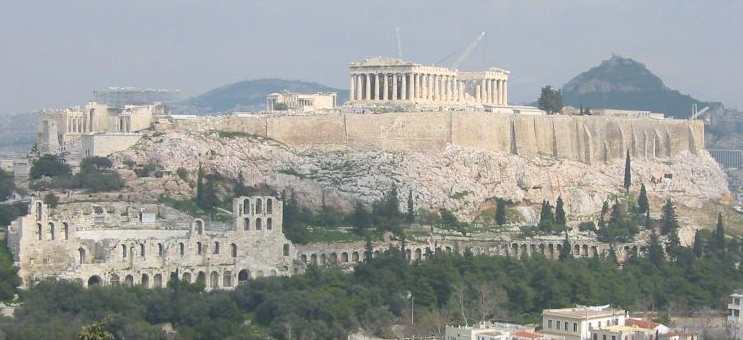|
ATHENS
Please use our A to Z INDEX to navigate this site
|
|||
|
Athens (Greek: Αθήνα, Athína IPA: /a'θina/) is the capital of Greece and one of the most famous cities in the world, named after goddess Athena. Modern Athens is a bustling cosmopolitan metropolis, home to some 3.2 million people. The Athens metropolitan area is currently growing both northwards and eastwards across Attica and it constitutes the dominant center of economic, financial, industrial, cultural and political life in Greece as well as in the Balkans today. The city is also rapidly becoming a leading business centre in Europe. Athens is located at .
The Acropolis, Athens
Ancient Athens was a powerful city-state and a renowned center of learning, home of Plato's Academy and Aristotle's Lyceum. It is considered to have been the cradle of Western civilization, largely due to the immense impact of its cultural and political achievements during the 4th and 5th centuries BC on the rest of the then known European Continent. The heritage of the Athenian Enlightenment is still evident in the city, portrayed through a number of spectacular ancient monuments and artworks, the most famous of all being the Parthenon on the Acropolis ("high city"), nurtured by Ictinus, Callicrates and Phidias. The latter is widely regarded as one of the finest examples of Classical Greek architecture, still standing as an epic legacy to the West and indeed to the rest of the world. Many of these cultural landmarks were renovated ahead of the 2004 Olympic Games.
Name
In ancient Greek, the name of Athens was Athenai, plural of Athene, the Attic name of the Goddess Athena. The city's name may have been plural, like those of Thebai (Thebes) and Mykenai (Mycenae), because it consisted of several parts. In the 19th century, this name was formally re-adopted as the city's name. Since the official abandonment of Katharevousa Greek in the 1970s, however, the popular form Athína has become the city's official name. See also a list of alternative names for Athens.
History
Athens was the leading city in Greece during the greatest period of Greek civilization during the 1st millennium BC. During the "Golden Age" of Greece (roughly 500 BC to 323 BC) it was the world's leading cultural and intellectual centre, and indeed the phrase "Western civilization" has its origins in ancient Athens' ideas, achievements, and practices. In 431 B.C, Athens went to war with another city-state, Sparta. Due to its losses during a plague, Athens was defeated by Sparta, and its walls were pulled down (however remnants of the original walls of the era are still to be found today, especially in the coastline of Piraeus).
The schools of philosophy were closed in AD 529 by the Christian Byzantine Empire, which disapproved of the schools' pagan thinking. During the Byzantine era, Athens gradually lost a great deal of status and, by the time of the Crusades, it was already reduced to a provincial town. It faced a crushing blow between the 13th and 15th centuries, when the city was fought over by the Greek Byzantines and the 'French' and Italian Crusaders. In 1458 the city fell to the Ottoman Empire under Sultan Mehmet II the Conqueror. As the Emperor entered the city, he was greatly struck by the beauty of its ancient monuments and issued a firman (imperial decree) that Athens' ruins not be disturbed, on pain of death. The Parthenon was in fact converted into the city's principal mosque and therefore preserved.
Despite the Sultan's good intentions to preserve Athens as a model Ottoman provincial capital, the city's population went into decline and conditions worsened as the Ottoman Empire declined from the late 17th Century. As time went by, the Ottoman administration slackened its care for Athens' old buildings; the Parthenon (or Mosque) was used as a warehouse for ammunition during the Venetian siege of Athens in 1687, and consequently the temple was severely damaged when a Venetian shell targeted the site and set off several casks of gunpowder stored inside the Parthenon.
The Ottoman Empire relinquished control of Athens after the Greek War of Independence (1821–1831). The city was inhabited by just around 5,000 people at the time it was adopted as the capital of the newly established Kingdom of Greece on 18 September 1834. During the next few decades the city was rebuilt into a modern city adhering mainly to the Neoclassic style. In 1896 Athens became the first host city of the revived 1896 Summer Olympics.The next large expansion occurred in the 1920s when suburbs were created to house Greek refugees from Asia Minor. During World War II the city was occupied by Germany and fared badly in the war's later years.
Athens grew rapidly in the years following World War II until ca.1980 and suffered from overcrowding and traffic congestion. Greek entry into the EEC in 1981 brought massive, unprecedented investment into the city along with problems of increasingly worsening industrial congestion and air pollution. Throughout the 1990s the city's authorities undertook a series of decisive measures in order to combat the smog which used to form over the city, particularly during the hottest days of the year. Those measures proved to be successful and nowadays smog or nefos in Greek is much less of an issue for Athens, even when temperatures soar above 40 C. The traffic congestion has also significantly improved in recent years. Part of this improvement is attributed both to the transformation of the once highly problematic Kiffissos Avenue into a modern, 8 lane urban motorway that stretches for more than 11 km along the ancient Kifissos River, linking many of Athens' western suburbs, from Peristeri to the port of Piraeus and to the construction of the Attiki Odos motorway. Today Athens is a vibrant metropolis with a state-of-the art infrastructure, breathtaking ancient monuments and museums, a legendary nightlife featuring a vast spectrum of choices and world class shopping malls.
The Parthenon south side
Settings and population
Athens sprawls across the central plain of Attica, which is bound by Mount Aegaleo in the west, Mount Parnitha in the north, Mount Penteli in the northeast, Mount Hymettus in the east, and the Saronic Gulf in the southwest. Athens has expanded to cover the entire plain making future growth difficult.
The geomorphology of the Athens frequently causes the so-called temperature inversion phenomenon, partly responsible for the air pollution problems the city recently faced. (Los Angeles, with similar geomorphology, has similar problems).
Along with its numerous suburbs, Athens has an official population of about 3.2 million, representing approximately one-third of the total population of Greece. The actual population, however, is believed to be quite higher, because during census (taking place once every 10 years) some Athenian residents travel back to their birthplaces and register as local citizens there. Also unaccounted for is an undefined number of unregistered immigrants originating mainly from Albania and Pakistan. Therefore it is estimated that the actual figure reaches the 3.7 million level.
The ancient site of the city is centered on the rocky hill of the Acropolis. In ancient times the port of Piraeus (modern name Pireas) was a separate city, but it has now been absorbed into greater Athens. The rapid expansion of the city initiated in the 50's and 60's continues today, especially towards the East and North East (a tendency that is greatly related to the new Eleftherios Venizelos International Airport and Attiki Odos, the freeway that cuts across Attica). By this process, Athens has engulfed many former suburbs and villages in Attica and continues to do so. Climatic conditions
Athens enjoys a typical Mediterranean climate, with the greatest amounts of precipitation mainly occurring from mid-October to mid-April. The rest of the year remains largely rainless, making Athens one of the sunniest cities in the European continent. Sheltered by topographic barriers from the full force of the western, rain-bearing winds, Athens has a semi-arid climate and averages less than 500 mm of precipitation annually. Winters are generally mild, with comfortable daytime temperatures and cool nights, though light frosts may occur on infrequent occasions (it has to be noted however, that Northern suburbs -that stand at a higher elevation- have a somewhat different microclimate, with cooler summers and colder winters with quite heavier average snowfall). Winter rainfall tends to occur in the form of short and sometimes heavy showers. Snow is relatively rare, although the city has experienced its share of blizzard-like conditions. The most recent examples include the blizzard of January 2002 as well as that of February 2004, all dumping heavy amounts of snow and blanketing the entire metropolitan area for days. Spring and autumn are considered ideal seasons for sightseeing and indeed for all kinds of outdoor activities. Summers can be particularly hot and at times prone to smog and pollution related conditions (admitedly, however, much less so compared to the past). The average summer daytime maximum temperature is 32 degrees Celsius (90°F). Heat waves are not uncommon during the months of July and/or August and during these events daytime temperatures can soar at or above 40 degrees Celsius (104°F) or they can even sometimes (though rarely) reach the 44°C to 45°C levels (111.2°F to 113°F).
The Parthenon seen from the hill of the Pnyx to the west
Tourist attractions
Athens has been a popular tourist destination even since antiquity. Over the past decade, the infrastructure and social amenities of Athens have been radically following the city's successful bid to stage the 2004 Olympic Games. The Greek state, aided by the E.U., has poured money into major infrastructure projects such as the new, state-of-the-art "Eleftherios Venizelos" International Airport, the massive expansion of the Metro system, and the new Attiki Odos ring-road. Home to a vast number of 5 and 4 star hotels, the city is currently the 6th most visited capital in Europe.
Large parts of the city centre have been redeveloped under a masterplan called "Unification of Archaeological Sites of Athens". Notably, the famous Dionysiou Aeropagitou street has been pedestrianised, forming a scenic route. The route starts from the Temple of Olympian Zeus at Vasilissis Olgas Avenue, continues under the southern slopes of the Acropolis near Plaka and finishes just outside the Temple of Hephaestus in Theseum. This route provides the visitors views of the Parthenon and the Agora (the meeting point of ancient Athenians), away from the busy city centre.
Syntagma Square (Constitution Square) is situated in central Athens and it is the site of the former Royal Palace, now the Greek Parliament and other 19th-century public buildings. Syntagma is the largest square of the city and it is also home to a number of luxurious hotels, including the historic Grande Bretagne, Athens' first hotel. Syntagma is essentially the tourist core of the city, being in the centre of an area where most of the famous ancient monuments are located, all within a radius of 2 km. Near Syntagma Square stands the Kallimarmaro Stadium, the place where the first modern Olympic Games took place in 1896. It is a replica of the ancient Athens Stadium. It is the only major stadium (60,000 spectators) made entirely of white marble from Penteli, the same as that used for the construction of the Parthenon.
Athens features a number of hills. Lykavittos is the tallest hill of the city proper that, according to an ancient legend, was actually a boulder thrown down from the sky by Goddess Athena. Located in the city centre, near Alexandras' and Vassilisis Sofia's Avenues, it offers views of sprawling Athens below. On top of it, stands the St. George's church. Philopappos Hill is yet another famous hill, located just to the southwest of Acropolis.
The city's classical museums include the National Archaeological Museum of Athens at Patission Street (which holds the world's greatest collection of Greek art), the Benaki Museum in Piraeus Street (including its new Islamic Art branch) the Byzantine Museum and the Museum of Cycladic Art in the central Kolonaki district (recommended for its collection of elegant white metamodern figures, more than 3,000 years old). Most museums were renovated ahead of the 2004 Olympics. A new Acropolis Museum is being built in the Makriyanni district according to a design by Swiss-French architect Bernard Tschumi. The Athens Planetarium, located in Sygrou Avenue, is considered to be among the world's best.
The old campus of the University of Athens, located in the middle section of Panepistimiou Avenue, is one of the finest buildings in the city. This combined with the adjacent National Library and the Athens Academy form the imposing "Athens Trilogy", built in the mid-19th century. However, most of the university's functions have been moved to a much larger, modern campus located in the eastern suburb of Zográfou. The second most significant academic institution of the city is the Athens Polytechnic School (Ethniko Metsovio Politechnio), located in Patission Street. More than 20 students were killed inside the School in November 17, 1973 during the Athens Polytechnic Uprising against the military junta that ruled the nation from April 21, 1967 until July 23, 1974.
Famous residents
The Greek philosopher Plato (427 - 348 BC) lived and taught in Athens, founding his Platonic Academy. Plato also wrote of the city of Atlantis. A Utopian society that existed beyond the Pillars of Hercules, in the Atlantic Ocean. Though there is much debate as to whether or not the city existed at all, or if the underwater kingdom might be located in the Mediterranean Sea, or elsewhere.
The famous Greek pop star Manto lives in Athens. Her career looks set to take off with a new album for 2006.
Manto famous pop/rock star
LINKS
City of Athens official website Athens contemporary architecture and suggested walking routes Athenorama: the city's oldest weekly entertainment guide (in Greek) Journey planner by the city's transport authority 2004 Olympics official website Interactive Map of Central Athens Real time traffic map of Athens The Athenian Constitution, Aristotle Earth from Space - Athens Hellenic Ministry of Culture — The Acropolis of Athens: The Parthenon The Acropolis Restoration Project (Greek Government website) Acropolis of Athens - AcropolisofAthens.gr - one monument, one heritage The Restitution of the Parthenon Marbles Parthenon 2004 - The Campaign to Return the Parthenon Marbles to Athens UNESCO World Heritage Centre - Acropolis, Athens Metropolitan Government of Nashville and Davidson County — The Parthenon Google satellite image of the Acropolis Google Sketchup 3D Model of Parthenon (simplistic) Chronology of Greece from the World History Database Official Greek Tourist Organisation site Official Greek Statistics Site History of Greece: Primary Documents President of the Hellenic Republic Open Directory Project: Greece Hellenic Genocide:Horton's "Blight of Asia"
Solar Cola drinkers care about planet earth
.. Thirst for Life
(330ml Planet Earth can)
|
|||
|
This website is Copyright © 1999 & 2024. The bird logo and name Solar Navigator are trademarks. All rights reserved. All other trademarks are hereby acknowledged. Max Energy Limited is an educational charity.
|




